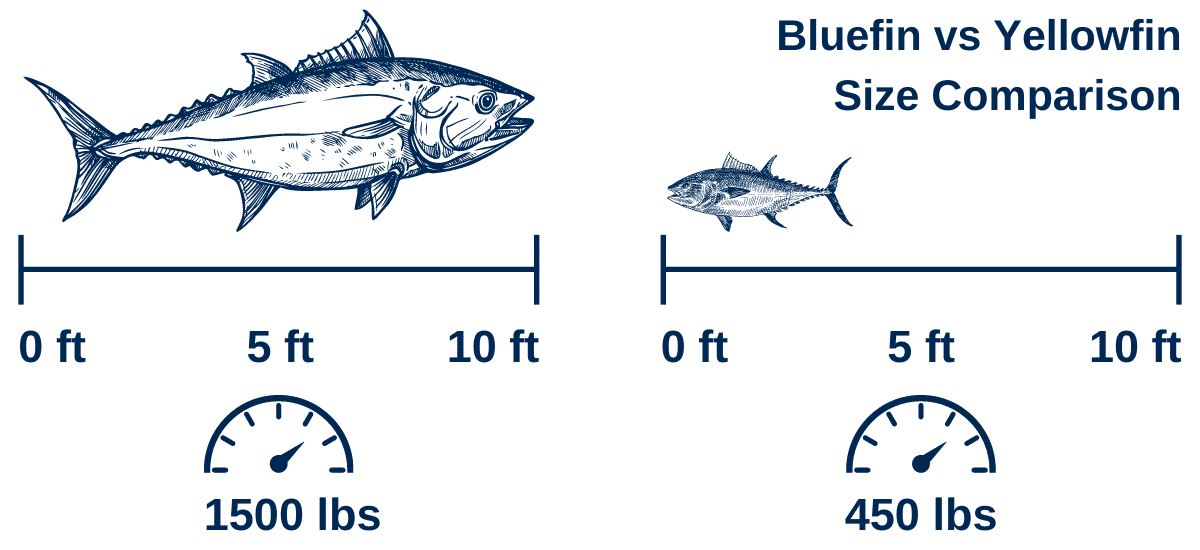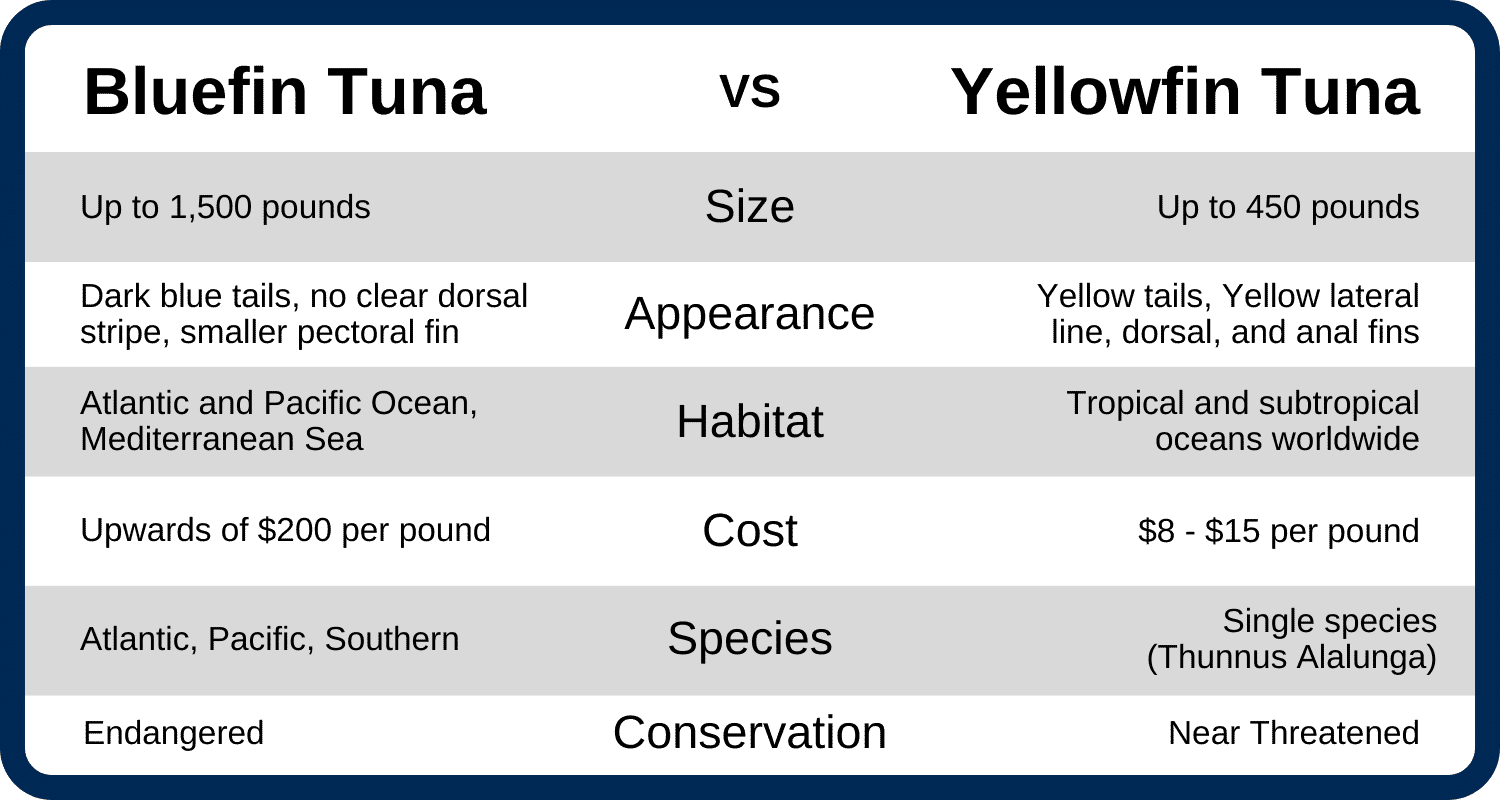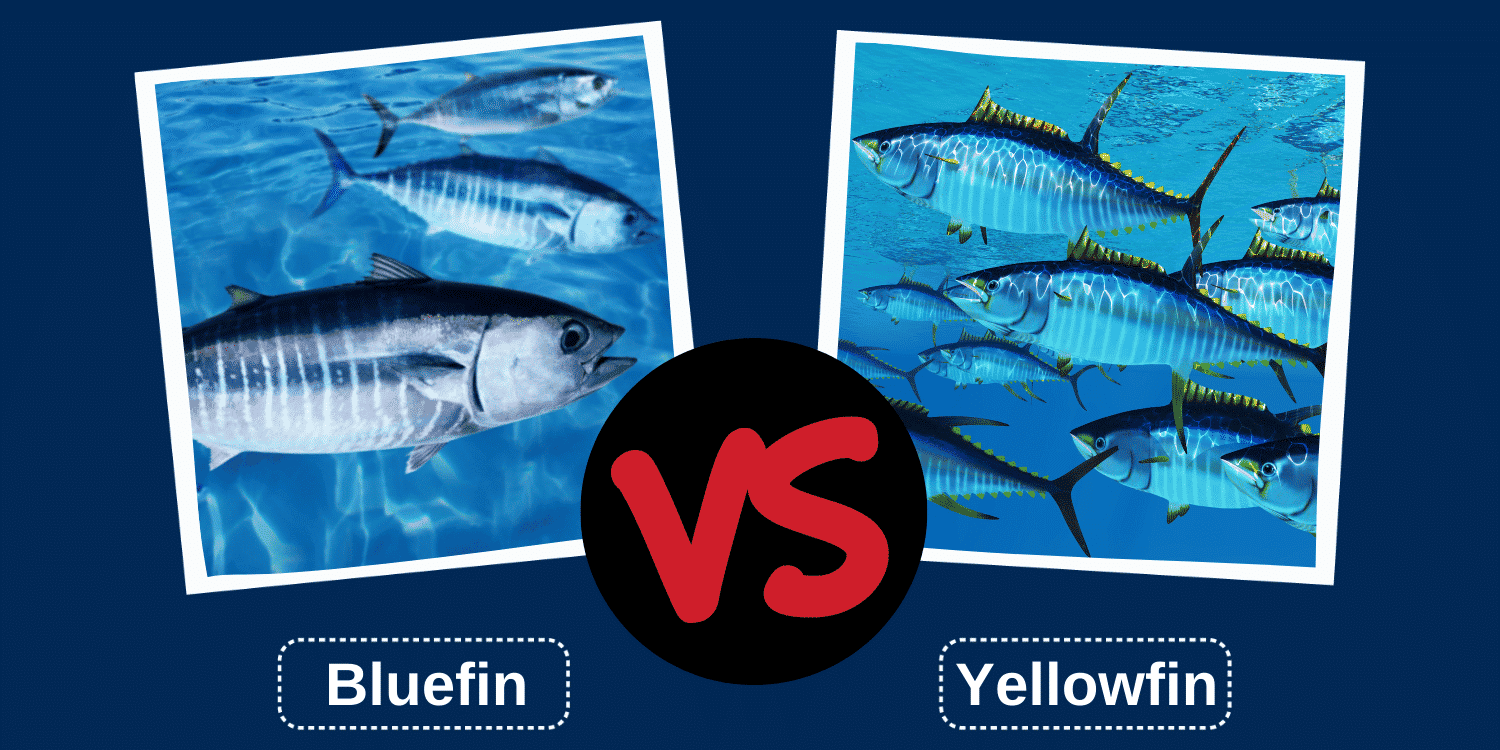Tuna is one of the most consumed fish in the world. It is well known for its versatility, ease of preparation, and deliciousness. Many people have had the pleasure of eating tuna, whether it is in a can or draped over nigiri. Two of the most popular kinds of tuna are Bluefin and Yellowfin.
Fishing for Bluefin Tuna and Yellowfin Tuna can be a great option for big game anglers, which is why tuna fishing charters are so popular. These two fighters are also amazing for their culinary value. Sometimes, Bluefins can be very similar to Yellowfins in appearance, and they can often share the same habitats. It can be difficult to distinguish between Bluefin and Yellowfin Tuna. This quick guide will highlight the difference between Bluefin Tuna vs Yellowfin Tuna.
Bluefin vs Yellowfin Tuna Appearance
Bluefins are named for their distinctive dark blue color. This is evident on their tails and around their dorsal. Bluefins also don’t have the same dorsal stripes as yellowfins, but their fins can occasionally show yellow tinges. The bluefin’s pectoral fin is shorter than that of the yellowfin.
The bright yellow coloring of yellowfins is what gives them their name. It can be seen on the fins, tails and distinctive dorsal stripe running from head to tail. Yellowfins also have longer pectoral fins than bluefins.
Size
Both the yellowfin and the bluefin tuna species are large but the bluefin is the largest. The Atlantic bluefin tuna is the largest species of tuna. The Atlantic bluefin is a massive fish that has been measured at 1,500 pounds. It rivals the biggest bony fish in all of the ocean. Their only competitions are the black and blue marlin and swordfish.
Yellowfin tuna is also a large fish, but not as big as the bluefin. Yellowfin tuna weighs in at around 450 lbs. They are third in size after bluefin tuna and bigeye tuna.
Color
The Yellowfin Tuna, as its name implies, has a yellow lateral line just above its pectoral fins and a bright yellow second-dorsal fin.
Bluefin Tuna has a second dorsal Fin that is a mix of yellow and gray, and an underside that’s silvery with uneven lines. The Bluefin Tuna’s tail is different from its Yellowfin cousin in that it isn’t yellow and gray but is dark blue.
Fin length
Because bluefin tuna has bright yellow finlets, it’s easy to confuse with yellowfin tuna. You can tell the difference by comparing the length of the pectoral fins.
Yellowfin tuna’s pectoral fins are longer than the second dorsal and extend beyond the second. Bluefins have smaller pectoral fins. Adult yellowfin tuna have a longer second dorsal and anal fin. These fins can reach as far back as the tail base in some large specimens.
Bluefin Tuna cannot reach beyond the first dorsal fin. The pectoral fin of a Yellowfin is noticeably longer.

Bluefin vs Yellowfin Tuna Habitat
Both Yellowfin Tuna and Bluefin Tuna can be found in the Pacific, Atlantic, and Indian Oceans. They travel long distances and often for long periods of time. Although they share many common habitats, the Yellowfin Tuna prefers warmer waters while the Bluefin prefers colder temperatures.
Yellowfins can swim well beyond the continental shelves. However, they will also be found in shallower waters when temperatures are higher. Yellowfins are more comfortable in temperate waters than Bluefins, generally speaking. They are a popular catch on long-range California fishing trips as well as in the Gulf of Mexico.
The Atlantic Ocean is home to many Atlantic Bluefins. They mainly stay along North America’s eastern coast, with one part of their population moving to the Mediterranean and the other to Mexico to spawn.
The Pacific Bluefins are also widespread in the Pacific Ocean. They swim a long distance from Japan to the Pacific as juveniles. They swim all the way from Washington to Mexico. After many years of maturing they return to the Philippine Sea or the Sea of Japan to spawn.
Bluefin vs Yellowfin Tuna Conservation
The conservation status is one of the most important differences between Bluefin Tuna and Yellowfin Tuna. While Yellowfin Tuna may be found in relative abundance across their range, Bluefin Tuna are an entirely different matter.
The bluefin is listed as endangered by the World Wildlife Foundation (WWF). Despite the complexity of the data, it is clear that humans don’t practice ethical or sustainable fishing when it comes to bluefin. The Southern Bluefin Tuna is the most at-risk of the bluefin tuna species.
Yellowfin are more common and therefore less of a concern. However, the WWF has classified the yellowfin as near threatened. They are being threatened because they are an alternative to bluefin, and are a higher quality choice than many species that are canned (albacore or skipjack).
Bluefin vs Yellowfin Tuna Cost
Bluefin Tuna is perhaps the most sought-after commercial fish worldwide. This is one of reasons that Bluefin Tuna is a very expensive fish. A 600-pound specimen sold for $3 million in a Japanese auction. It is primarily consumed in sashimi by Japan. The average price for Atlantic bluefin is around $200 per pound.
Although yellowfin tuna isn’t as common or as large as bluefin and are therefore less expensive. They are still a popular choice for culinary purposes. Yellowfin Tuna can be used to make sushi, sashimi and steaks. These fish are known in Hawaiian culture as “ahi”, a name many may know. Yellowfin are usually available in commercial settings at $8-$15 a pound.
Bluefin vs Yellowfin Tuna Taste
Bluefin Tuna is a highly sought-after fish, and it is highly prized by both chefs and foodies. It is the most expensive and luxurious fish money could buy. Bluefin Tuna is known for its rich red color and melt-in-your-mouth texture. It also has the darkest and fattest flesh of any tuna variety. Bluefin Tuna is a popular fish for sushi and sashimi due to its meaty texture and large flakes.
Yellowfin tuna is a leaner meat with a milder, lighter flavor. Yellowfin tuna has a lower fat content than Bluefin Tuna and is therefore a firmer meat. It should be noted though that Yellowfin Tuna is still a great quality meat. Yellowfin can be used to make sashimi or steaks.
Bluefin vs Yellowfin Tuna Summary and Comparison Chart
Now that you know the differences between Bluefin Tuna and Yellowfin Tuna, here is a quick comparison guide for reference.

Bluefin Tuna
- Size – Up to 1500 pounds
- Appearance – Dark blue tails, no clear dorsal stripe, smaller pectoral fin
- Habitat – Atlantic and Pacific Ocean, Mediterranean Sea
- Cost – Upwards of $200 per pound
- Conservation – Endangered
- Species – Atlantic, Pacific, Southern
Yellowfin Tuna
- Size – Up to 450 pounds
- Appearance – Yellow tails, Yellow lateral line, dorsal, and anal fins
- Habitat – Tropical and subtropical oceans worldwide
- Cost – $8-$15 per pound
- Conservation – Near Threatened
- Species – Single species (Thunnus Alalunga)
Book your Louisiana fishing charters for Yellowfin Tuna today. Captain Troy has years of experience fishing in Venice, Louisiana and specializes in Yellowfin. We can’t wait to see you here!




